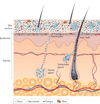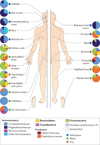The skin microbiome
- PMID: 21407241
- PMCID: PMC3535073
- DOI: 10.1038/nrmicro2537
The skin microbiome
Erratum in
- Nat Rev Microbiol. 2011 Aug;9(8):626
Abstract
The skin is the human body's largest organ, colonized by a diverse milieu of microorganisms, most of which are harmless or even beneficial to their host. Colonization is driven by the ecology of the skin surface, which is highly variable depending on topographical location, endogenous host factors and exogenous environmental factors. The cutaneous innate and adaptive immune responses can modulate the skin microbiota, but the microbiota also functions in educating the immune system. The development of molecular methods to identify microorganisms has led to an emerging view of the resident skin bacteria as highly diverse and variable. An enhanced understanding of the skin microbiome is necessary to gain insight into microbial involvement in human skin disorders and to enable novel promicrobial and antimicrobial therapeutic approaches for their treatment.
Figures




Similar articles
-
The skin microbiome: current perspectives and future challenges.J Am Acad Dermatol. 2013 Jul;69(1):143-55. doi: 10.1016/j.jaad.2013.01.016. Epub 2013 Mar 13. J Am Acad Dermatol. 2013. PMID: 23489584 Free PMC article. Review.
-
Functions of the skin microbiota in health and disease.Semin Immunol. 2013 Nov 30;25(5):370-7. doi: 10.1016/j.smim.2013.09.005. Epub 2013 Nov 20. Semin Immunol. 2013. PMID: 24268438 Free PMC article. Review.
-
The microbiome in patients with atopic dermatitis.J Allergy Clin Immunol. 2019 Jan;143(1):26-35. doi: 10.1016/j.jaci.2018.11.015. Epub 2018 Nov 23. J Allergy Clin Immunol. 2019. PMID: 30476499 Free PMC article. Review.
-
Commensal bacteria and cutaneous immunity.Semin Immunopathol. 2015 Jan;37(1):73-80. doi: 10.1007/s00281-014-0452-6. Epub 2014 Oct 18. Semin Immunopathol. 2015. PMID: 25326105 Review.
-
Microbiology of the skin: resident flora, ecology, infection.J Am Acad Dermatol. 1989 Mar;20(3):367-90. doi: 10.1016/s0190-9622(89)70048-7. J Am Acad Dermatol. 1989. PMID: 2645319 Review.
Cited by
-
Role of microbes in the pathogenesis of neuropsychiatric disorders.Front Neuroendocrinol. 2021 Jul;62:100917. doi: 10.1016/j.yfrne.2021.100917. Epub 2021 May 4. Front Neuroendocrinol. 2021. PMID: 33957173 Free PMC article. Review.
-
Tracing skin aging process: a mini- review of in vitro approaches.Biogerontology. 2021 Jun;22(3):261-272. doi: 10.1007/s10522-021-09916-z. Epub 2021 Mar 15. Biogerontology. 2021. PMID: 33721158 Review.
-
Skin flora: Differences between people affected by Albinism and those with normally pigmented skin in Northern Tanzania - cross sectional study.BMC Dermatol. 2012 Jul 30;12:12. doi: 10.1186/1471-5945-12-12. BMC Dermatol. 2012. PMID: 22846672 Free PMC article.
-
Pan-genome and comparative genome analyses of propionibacterium acnes reveal its genomic diversity in the healthy and diseased human skin microbiome.mBio. 2013 Apr 30;4(3):e00003-13. doi: 10.1128/mBio.00003-13. mBio. 2013. PMID: 23631911 Free PMC article.
-
Significant changes in the skin microbiome mediated by the sport of roller derby.PeerJ. 2013 Mar 12;1:e53. doi: 10.7717/peerj.53. Print 2013. PeerJ. 2013. PMID: 23638391 Free PMC article.
References
-
- Chiller K, Selkin BA, Murakawa GJ. Skin microflora and bacterial infections of the skin. J. Investig. Dermatol. Symp. Proc. 2001;6:170–174. - PubMed
-
- Fredricks DN. Microbial ecology of human skin in health and disease. J. Investig. Dermatol. Symp. Proc. 2001;6:167–169. - PubMed
-
-
Marples M. The Ecology of the Human Skin. Bannerstone House, Springfield, Illinois: Charles C Thomas; 1965. A seminal and comprehensive work of classical dermatological microbiology.
-
-
- Roth RR, James WD. Microbial ecology of the skin. Annu. Rev. Microbiol. 1988;42:441–464. - PubMed
-
- Noble WC. Skin microbiology: coming of age. J. Med. Microbiol. 1984;17:1–12. - PubMed
Publication types
MeSH terms
Grants and funding
LinkOut - more resources
Full Text Sources
Other Literature Sources

